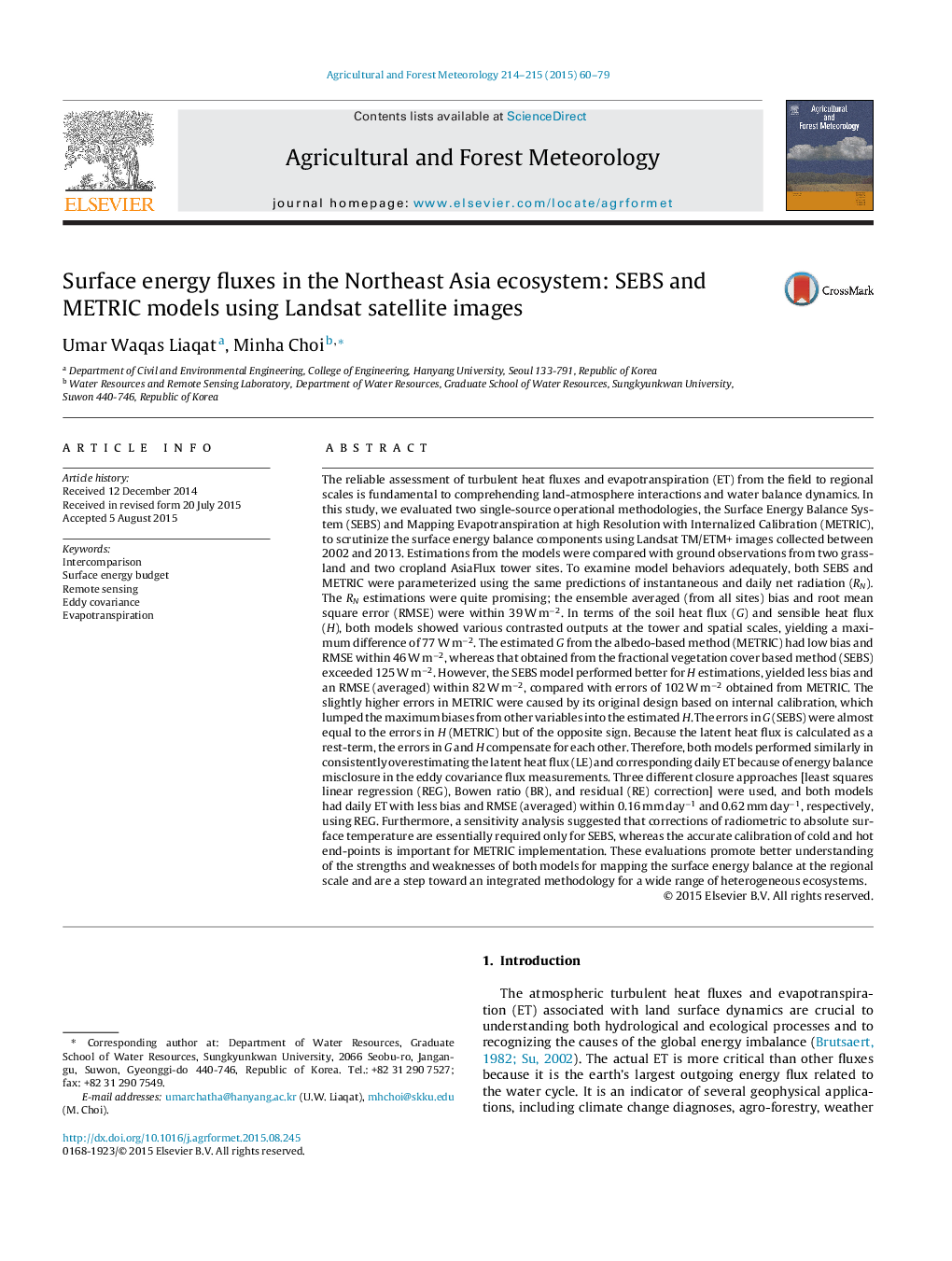| کد مقاله | کد نشریه | سال انتشار | مقاله انگلیسی | نسخه تمام متن |
|---|---|---|---|---|
| 6537152 | 158324 | 2015 | 20 صفحه PDF | دانلود رایگان |
عنوان انگلیسی مقاله ISI
Surface energy fluxes in the Northeast Asia ecosystem: SEBS and METRIC models using Landsat satellite images
دانلود مقاله + سفارش ترجمه
دانلود مقاله ISI انگلیسی
رایگان برای ایرانیان
کلمات کلیدی
موضوعات مرتبط
مهندسی و علوم پایه
علوم زمین و سیارات
علم هواشناسی
پیش نمایش صفحه اول مقاله

چکیده انگلیسی
The reliable assessment of turbulent heat fluxes and evapotranspiration (ET) from the field to regional scales is fundamental to comprehending land-atmosphere interactions and water balance dynamics. In this study, we evaluated two single-source operational methodologies, the Surface Energy Balance System (SEBS) and Mapping Evapotranspiration at high Resolution with Internalized Calibration (METRIC), to scrutinize the surface energy balance components using Landsat TM/ETM+ images collected between 2002 and 2013. Estimations from the models were compared with ground observations from two grassland and two cropland AsiaFlux tower sites. To examine model behaviors adequately, both SEBS and METRIC were parameterized using the same predictions of instantaneous and daily net radiation (RN). The RN estimations were quite promising; the ensemble averaged (from all sites) bias and root mean square error (RMSE) were within 39 W mâ2. In terms of the soil heat flux (G) and sensible heat flux (H), both models showed various contrasted outputs at the tower and spatial scales, yielding a maximum difference of 77 W mâ2. The estimated G from the albedo-based method (METRIC) had low bias and RMSE within 46 W mâ2, whereas that obtained from the fractional vegetation cover based method (SEBS) exceeded 125 W mâ2. However, the SEBS model performed better for H estimations, yielded less bias and an RMSE (averaged) within 82 W mâ2, compared with errors of 102 W mâ2 obtained from METRIC. The slightly higher errors in METRIC were caused by its original design based on internal calibration, which lumped the maximum biases from other variables into the estimated H. The errors in G (SEBS) were almost equal to the errors in H (METRIC) but of the opposite sign. Because the latent heat flux is calculated as a rest-term, the errors in G and H compensate for each other. Therefore, both models performed similarly in consistently overestimating the latent heat flux (LE) and corresponding daily ET because of energy balance misclosure in the eddy covariance flux measurements. Three different closure approaches [least squares linear regression (REG), Bowen ratio (BR), and residual (RE) correction] were used, and both models had daily ET with less bias and RMSE (averaged) within 0.16 mm dayâ1 and 0.62 mm dayâ1, respectively, using REG. Furthermore, a sensitivity analysis suggested that corrections of radiometric to absolute surface temperature are essentially required only for SEBS, whereas the accurate calibration of cold and hot end-points is important for METRIC implementation. These evaluations promote better understanding of the strengths and weaknesses of both models for mapping the surface energy balance at the regional scale and are a step toward an integrated methodology for a wide range of heterogeneous ecosystems.
ناشر
Database: Elsevier - ScienceDirect (ساینس دایرکت)
Journal: Agricultural and Forest Meteorology - Volumes 214â215, 15 December 2015, Pages 60-79
Journal: Agricultural and Forest Meteorology - Volumes 214â215, 15 December 2015, Pages 60-79
نویسندگان
Umar Waqas Liaqat, Minha Choi,